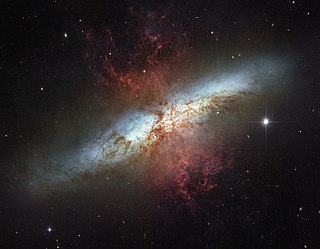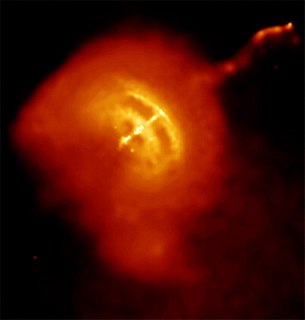
A supernova remnant (SNR) is the structure resulting from the explosion of a star in a supernova. The supernova remnant is bounded by an expanding shock wave, and consists of ejected material expanding from the explosion, and the interstellar material it sweeps up and shocks along the way.

The Crab Nebula is a supernova remnant and pulsar wind nebula in the constellation of Taurus. The common name comes from William Parsons, 3rd Earl of Rosse, who observed the object in 1840 using a 36-inch (91 cm) telescope and produced a drawing that looked somewhat like a crab. The nebula was discovered by English astronomer John Bevis in 1731, and it corresponds with a bright supernova recorded by Chinese astronomers in 1054. The nebula was the first astronomical object identified that corresponds with a historical supernova explosion.

Messier 82 is a starburst galaxy approximately 12 million light-years away in the constellation Ursa Major. A member of the M81 Group, it is about five times more luminous than the Milky Way and has a center one hundred times more luminous. The starburst activity is thought to have been triggered by interaction with neighboring galaxy M81. As the closest starburst galaxy to Earth, M82 is the prototypical example of this galaxy type. SN 2014J, a type Ia supernova, was discovered in the galaxy on 21 January 2014. In 2014, in studying M82, scientists discovered the brightest pulsar yet known, designated M82 X-2.

The Tarantula Nebula is an H II region in the Large Magellanic Cloud (LMC), from the Solar System's perspective forming its south-east corner.

The Eagle Nebula is a young open cluster of stars in the constellation Serpens, discovered by Jean-Philippe de Cheseaux in 1745–46. Both the "Eagle" and the "Star Queen" refer to visual impressions of the dark silhouette near the center of the nebula, an area made famous as the "Pillars of Creation" imaged by the Hubble Space Telescope. The nebula contains several active star-forming gas and dust regions, including the aforementioned Pillars of Creation.

A pulsar wind nebula, sometimes called a plerion, is a type of nebula sometimes found inside the shell of a supernova remnant (SNR), powered by winds generated by a central pulsar. These nebulae were proposed as a class in 1976 as enhancements at radio wavelengths inside supernova remnants. They have since been found to be infrared, optical, millimetre, X-ray and gamma ray sources.

SS 433 is one of the most exotic star systems observed. It is an eclipsing X-ray binary system, with the primary most likely a black hole, or possibly a neutron star. The spectrum of the secondary companion star suggests that it is a late A-type star. SS 433 is the first discovered microquasar. It is at the centre of the supernova remnant W50.

Cassiopeia A (Cas A) is a supernova remnant (SNR) in the constellation Cassiopeia and the brightest extrasolar radio source in the sky at frequencies above 1 GHz. The supernova occurred approximately 11,000 light-years (3.4 kpc) away within the Milky Way; given the width of the Orion Arm it is placed in the next-nearest arm outwards, the Perseus Arm, about 30 degrees from the Galactic anticenter. The expanding cloud of material left over from the supernova now appears approximately 10 light-years (3 pc) across from Earth's perspective. In wavelengths of visible light, it has been seen with amateur telescopes down to 234 mm (9.25 in) with filters.

SN 1572, or B Cassiopeiae, was a supernova of Type Ia in the constellation Cassiopeia, one of eight supernovae visible to the naked eye in historical records. It appeared in early November 1572 and was independently discovered by many individuals.

W49B is a nebula in Westerhout 49 (W49). The nebula is a supernova remnant, probably from a type Ib or Ic supernova that occurred around 1,000 years ago. It may have produced a gamma-ray burst and is thought to have left a black hole remnant.

The Cygnus Loop is a large supernova remnant (SNR) in the constellation Cygnus, an emission nebula measuring nearly 3° across. Some arcs of the loop, known collectively as the Veil Nebula or Cirrus Nebula, emit in the visible electromagnetic range. Radio, infrared, and X-ray images reveal the complete loop.

NGC 2736 is a small part of the Vela Supernova Remnant, located near the Vela Pulsar in the constellation Vela. The nebula's linear appearance triggered its popular name. It resides about 815 light-years away from the Solar System. It is thought to be formed from part of the shock wave of the larger Vela Supernova Remnant. The Pencil Nebula is moving at roughly 644,000 kilometers per hour.

The Vela Pulsar is a radio, optical, X-ray- and gamma-emitting pulsar associated with the Vela Supernova Remnant in the constellation of Vela. Its parent Type II supernova exploded approximately 11,000–12,300 years ago.

The Vela supernova remnant is a supernova remnant in the southern constellation Vela. Its source Type II supernova exploded approximately 11,000–12,300 years ago. The association of the Vela supernova remnant with the Vela pulsar, made by astronomers at the University of Sydney in 1968, was direct observational evidence that supernovae form neutron stars.

The Gum Nebula is an emission nebula that extends across 36° in the southern constellations Vela and Puppis. It lies approximately 450 parsecs from the Earth. Hard to distinguish, it was widely believed to be the greatly expanded remains of a supernova that took place about a million years ago. More recent research suggests it may be an evolved H II region. It contains the 11,000-year-old Vela Supernova Remnant, along with the Vela Pulsar.

The Veil Nebula is a cloud of heated and ionized gas and dust in the constellation Cygnus.

IC 443 is a galactic supernova remnant (SNR) in the constellation Gemini. On the plane of the sky, it is located near the star Eta Geminorum. Its distance is roughly 5,000 light years from Earth.

The known history of supernova observation goes back to 185 AD, when supernova SN 185 appeared; which is the oldest appearance of a supernova recorded by humankind. Several additional supernovae within the Milky Way galaxy have been recorded since that time, with SN 1604 being the most recent supernova to be observed in this galaxy.

G292.0+01.8 is a supernova remnant located in the constellation Centaurus. It first gained notice as a strong radio source, and eventually deep images revealed a hot optical nebula at the location. It lies about 15,000 light years away.

Simeis 147, also known as the Spaghetti Nebula, SNR G180.0-01.7 or Sharpless 2-240, is a supernova remnant (SNR) in the Milky Way, straddling the border between the constellations Auriga and Taurus. Discovered in 1952 at the Crimean Astrophysical Observatory using a 25-inch Schmidt-Cassegrain telescope, it is difficult to observe due to its extremely low brightness.

















